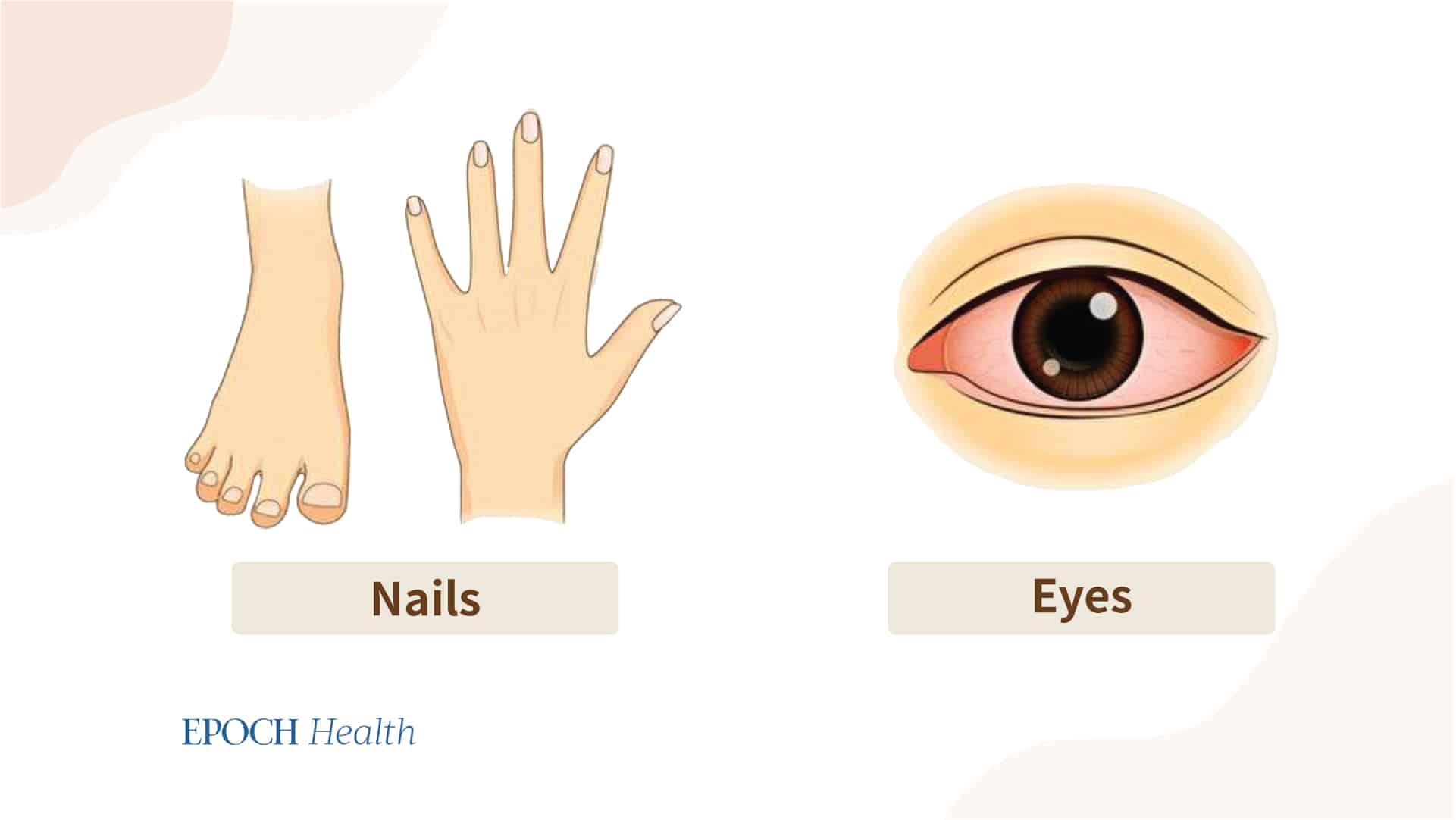
Unveiling Liver Health: The Visible Clues In Two Body Parts & A Method To Enhance Liver Function
Why is Liver health important?
By: Dr. Wu Kuo-Pin | The Epoch Times
A healthy liver is vital to the overall function of the body. To improve liver health, it is crucial to first have a proper understanding of the liver in traditional Chinese medicine (TCM). Whereas Western medicine views the liver as a single organ, TCM considers the liver as a comprehensive system that includes the circulatory system, digestive system, nervous system, endocrine system, and more.
According to traditional Chinese medicine, one of the primary physiological functions of the liver is “governing dispersion and dredging.” This means that the liver’s qi (energy) plays a crucial role in promoting smooth flow and circulation throughout the body, facilitating the movement and distribution of essential substances such as essence, blood, and body fluids. It is also responsible for regulating the “ascending and descending functions of the spleen and stomach,” bile secretion, and emotional well-being.
Dr. Samuel Ball Explains What Alcohol Really Does To Your Brain And Body
In other words, when the liver’s function of dispersion and regulation is normal, the qi flows smoothly and the physiological activities of various tissues and organs in the body remain balanced. However, if the liver function is compromised and the proper dispersion of qi and blood is disrupted, it may lead to imbalances in bodily functions and give rise to various disorders such as high blood pressure, dizziness, chest discomfort, insomnia, paranoia, depression, irritability, and more.
Assessing Liver Function through Nails & Eyes
The liver plays a vital role in detoxification, yet it is a silent organ without nerves, making it difficult to detect abnormalities. Traditional Chinese medicine uses the theory of Zang Xiang to assess liver function based on external manifestations. A TCM saying states, “The vitality of the liver is reflected in the nails, its influence extends to the eyes, its emotion is expressed through anger, and its fluid is manifested as tears.”
In the theory of Zang Xiang, “Zang” refers to the internal organs residing within the body, while “Xiang” refers to the external manifestations of physiological and pathological conditions. Zang Xiang is a specialized theory that studies the physiological functions, pathological changes, and interrelationships of the organs in the human body.
So, how does traditional Chinese medicine assess liver function from the nails and eyes?

-
Assessing Liver Function through Nails
According to the classic TCM text, the Yellow Emperor’s Classic of Internal Medicine, the colour and appearance of nails can provide insights into the abundance or deficiency of liver blood and indicate the overall health of the liver function. This applies to both fingernails and toenails. For example:
- Nails that appear glossy and red, along with a strong texture, indicate an abundance of blood in the liver and nourishment of the tendons and fascia. This suggests healthy liver function.
- Nails that appear pale, soft, thin, and prone to deformation or breakage indicate deficiency of blood and a lack of nourishment to the tendons and fascia. This suggests poor liver function.
-
Assessing Liver Function through Eyes
In traditional Chinese medicine, the sensory organs are considered the portals to the internal organs. It is believed that the eyes reflect the state of the liver, the tongue reflects the state of the heart, the mouth reflects the state of the spleen, the nose reflects the state of the lungs, and the ears reflect the state of the kidneys. When the internal organs are functioning poorly or experiencing abnormalities, specific signs may appear in their corresponding sensory organs. Therefore, the eyes serve as a crucial indicator for assessing liver function.
The visual function of the eyes depends on the nourishment of the essence from the internal organs, with the liver playing a crucial role. In the Yellow Emperor’s Classic of Internal Medicine, it is stated that “The liver’s qi flows to the eyes; when the liver is in harmony, the eyes can perceive colours distinctly.” This implies that when the liver is functioning well, the eyes naturally appear bright and vibrant, enabling clear vision. Conversely, eye issues may indicate an underlying problem with liver function.
Below are two clinical cases that demonstrate the close association between the liver and the eyes.
A male patient in his 50s, who had a history of working night shifts extensively during his younger years, had been hospitalized twice due to hepatitis, with the second episode being more severe. Approximately a week after being discharged, he developed blurred vision in both eyes, accompanied by the presence of dark shadows obstructing his vision. Upon examination by an ophthalmologist, it was diagnosed as optic nerve atrophy.
In another case, a female patient in her 50s suffered from congenital colour blindness, resulting in minimal colour perception and a world in shades of black and white. Additionally, she also experienced persistent blurry vision. Following a three-week acupuncture and medication treatment, her vision gradually improved. One day, she had a remarkable breakthrough when she saw the blue sky for the first time, filling her with immense joy. However, after getting into a heated argument with her brother, her vision immediately became blurry again (as rage impairs liver), undoing the progress made from the previous treatment.
Subsequently, she continued the treatment for another six months. While her vision improved and the colours she perceived became more vivid and vibrant, she noticed that the contrast and vibrancy of the blue sky were not as striking as they had been prior to her outburst. From that moment onward, she refrained from losing her temper, recognizing the significant impact that anger had on her overall well-being.
Enhancing Liver Function with Meridian Tapping Techniques
According to traditional Chinese medicine, meridians are pathways for the flow of energy in the body. They play a crucial role in transporting qi and blood throughout the entire body, which are the fundamental substances that constitute and sustain human life. The body consists of 12 major meridians, each corresponding to a specific organ. The internal organs are connected to the body’s surface through these meridians. Along the meridians, there are specific points known as acupoints, which possess unique functions. By stimulating the corresponding acupoints through techniques like acupuncture and massage, it is possible to treat diseases related to specific organs.
Tapping the liver and gallbladder meridians approximately 100 to 200 times every day can help improve liver and gallbladder function and promote metabolism.
In fact, tapping the liver and gallbladder meridians daily has shown remarkable therapeutic effects, especially during the acute or progressive phases of liver function abnormalities and jaundice.
Liver meridian tapping position: Along the inner side of the thigh, following the pathway of the liver meridian.
Gallbladder meridian tapping position: Tapping along the meridian, starting from the top and moving downwards until reaching the front of the outer ankle on the dorsum of the foot.

Three Key Tips For Maintaining Liver Health In Traditional Chinese Medicine
To promote liver health and ensure optimal detoxification function, you can make changes in the following three aspects of your daily life:
1. The Primary Aspect of Liver Nurturing Is To Manage Anger
The primary focus of liver nurturing is to refrain from anger. Instead of becoming upset or angry over any unfavorable circumstances, learn to regulate your emotions and face them with a calm and accepting mind-set.
In traditional Chinese medicine, it is believed that humans experience seven emotions known as joy, anger, anxiety, contemplation, sadness, fear, and fright. Additionally, each emotion corresponds to a specific organ, and these emotions are considered manifestations of the mental activities of the corresponding organs.
The liver is associated with the emotion of anger in Traditional Chinese Medicine. According to the Yellow Emperor’s Classic of Internal Medicine, it is stated that “Liver disease causes a person to easily become irritable.” This suggests that individuals with liver disease are more prone to experiencing anger, leading to stagnant qi and impaired flow. The female patient case mentioned earlier further supports this notion, as her loss of temper resulted in detrimental effects on her vision. It is important that we this lesson to heart and avoid excessive anger, as it can contribute to the development of liver disease.
If you find yourself feeling unusually irritable without any apparent cause, it is recommended to consume rose tea. To prepare rose tea, simply steep 6 to 10 grams of rose petals in a teapot with boiling water, cover the teapot, and let it steep for a while before drinking the tea.
2. Maintain A Balanced Lifestyle with Proper Work/Rest Balance
In Traditional Chinese medicine, it is believed that the 12 major meridians follow specific time arrangements and pathways. There are 12 “shi chen” (each representing a two-hour period in modern times) in a day, and they correspond to the 12 major meridians in the human body. During each “shi chen,” the corresponding meridian experiences a heightened flow of qi and blood, leading to increased activity in the associated organs. This concept is similar to the circadian rhythm that is now recognized in the human body.
It is recommended to go to bed no later than 10:30 p.m. The gallbladder meridian is active during the “zi” period (11 p.m. to 1 a.m.), while the liver meridian is active from 1 a.m. to 3 a.m. Maintaining a regular sleep schedule is crucial for nurturing the liver and gallbladder. In modern lifestyles, staying up late has become common, but prolonged wakefulness beyond the “zi” period can lead to weakened immune function and various health conditions. If you experience chronic mental stress or excessive physical fatigue, it is recommended to adjust your bedtime to 9 p.m.
In addition, TCM believes that nurturing the kidneys is associated with nurturing the liver, and the optimal time to sleep for kidney health is from 9 p.m. to 3 a.m. People who engage in strenuous work or stay up late past 9 p.m. are more susceptible to depleting their kidney’s energy. Excessive depletion can result in symptoms such as insomnia, high blood pressure, and even conditions like Parkinson’s disease.
Sexual activity should be moderated: It is not recommended to engage in sexual activity when one partner is affected by acute or chronic hepatitis. During the recovery phase of acute hepatitis, as well as the relatively stable phase of chronic hepatitis and cirrhosis, it is advisable to temporarily suspend sexual activity. This is because sexual activity can cause increased blood pressure, rapid breathing, accelerated heartbeat, physical exertion, and lead to inadequate liver oxygen supply (referred to as “water (kidney) failing to nourish wood (liver)” in TCM). This can hinder the patient’s recovery process and potentially exacerbate the condition.
Balancing work and rest: Individuals with acute and chronic liver disease should avoid overexertion and prioritize adequate rest. At the same time, it is advisable to engage in moderate physical activity to build physical strength and enhance the body’s immune system.
3. Be Mindful of Dietary Choices & Restrictions
In addition to regulating emotions, developing healthy habits, and balancing work and rest, diet also plays a crucial role in nurturing the liver. Along with quitting smoking and alcohol, it is advisable to follow a light and easily digestible diet. It is recommended to avoid consuming spicy foods like chili peppers, as well as certain meats such as rooster, duck, and lamb. Additionally, foods such as taro, bamboo shoots, green onions, garlic, hairtail fish, shrimp, mangoes, durian, longan, and lychee should be avoided.
* * *
NEXT UP!
Why Do Those Who Don’t Drink Alcohol Have Liver Cancer?
Liver cancer ranks as the fifth most common cancer and has been the third leading cause of cancer death in Hong Kong for years. However, there are still many misconceptions about liver cancer, which can easily affect the process of treatment and recovery.
Dr. Ka Wing Ma, general surgery consultant and clinical director at the Hepatobiliary and Pancreatic Diagnostic and Treatment Centre (HPDTC) at Hong Kong Adventist Hospital (HKAP), Tsuen Wan, Hong Kong, pointed out that in Hong Kong and East Asia, primary liver cancer is mostly induced by chronic hepatitis B. According to the clinical data of the HPDTC at HKAP, more than 90% of liver cancer cases had hepatitis B virus in their bodies.
Other common risk factors for liver cancer include chronic hepatitis C, type 2 diabetes, smoking, obesity, and a history of liver cancer in the family. Excessive alcohol consumption is just one of the high-risk factors.
* * *
READ MORE: Hawthorn Berries Can Benefit Your Heart, Liver & Skin
Read more on Liver Health: Natural Ways To Reverse Fatty Liver
Liked it? Take a second to support Collective Spark.
We’d love to hear from you! If you have a comment about this article or if you have a tip for a future Collective Spark Story please let us know below in the comment section.
